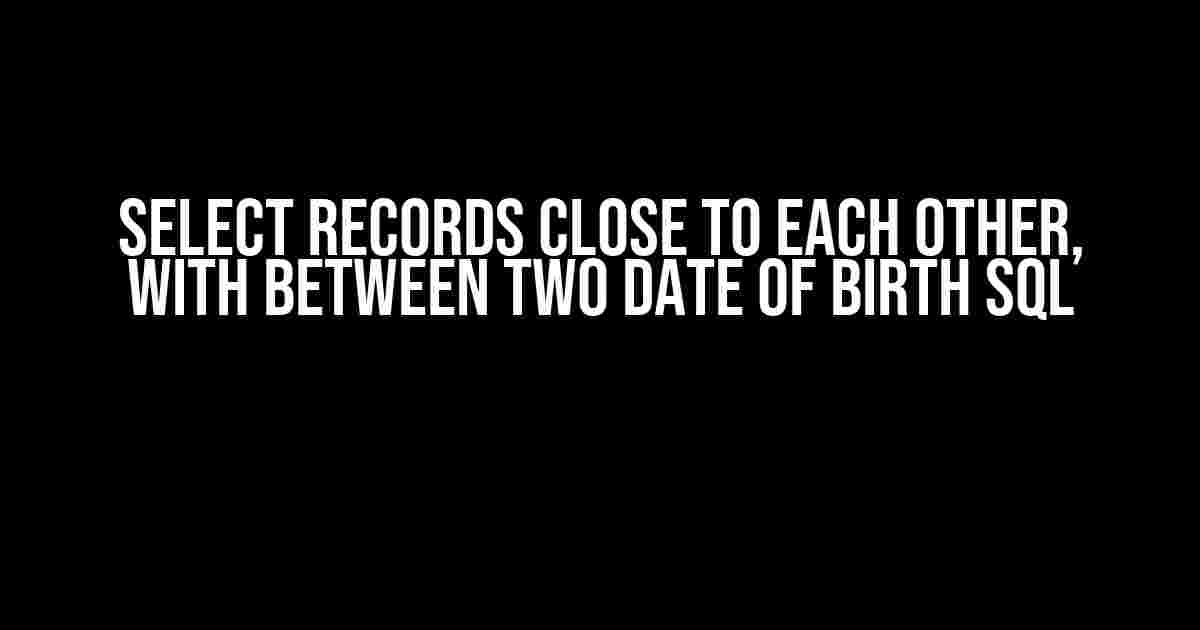Are you tired of sifting through a sea of birth dates, trying to find the ones that are closest to each other? Do you dream of writing a SQL query that can do the hard work for you? Well, dream no more! In this article, we’ll show you how to select records close to each other, with between two dates of birth using SQL.
Why do we need to select records close to each other?
In many real-world scenarios, we need to identify records that are close to each other in terms of a specific field, such as date of birth. For instance, in a database of customers, we might want to find all the customers who were born within a certain range of each other. This can be useful for targeted marketing campaigns, identifying trends, or even detecting fraudulent activity.
The problem with traditional SQL queries
Traditional SQL queries often rely on simple equality or range-based comparisons, which can be limiting when trying to find records close to each other. For example, if we want to find all customers born within 5 years of each other, a traditional query might look like this:
SELECT *
FROM customers
WHERE date_of_birth BETWEEN '1990-01-01' AND '1995-01-01';
This query would return all customers born between 1990 and 1995, but it wouldn’t help us find customers who were born, say, 3 years apart. We need a more sophisticated approach…
Introducing the DATEDIFF function
The DATEDIFF function is a powerful tool that allows us to calculate the difference between two dates in a variety of units (days, months, years, etc.). By combining DATEDIFF with some clever logic, we can write a query that finds records close to each other.
The basic idea
Let’s say we want to find all customers who were born within 5 years of each other. We can use DATEDIFF to calculate the difference in years between each customer’s date of birth and a reference date (e.g., the current date). Then, we can use a subquery to find the customers who have a difference within our desired range (5 years, in this case).
WITH ranked_customers AS (
SELECT
customer_id,
date_of_birth,
DATEDIFF(CURRENT_DATE, date_of_birth) AS age_in_years
FROM customers
)
SELECT *
FROM ranked_customers
WHERE age_in_years BETWEEN (SELECT MIN(age_in_years) FROM ranked_customers) - 5
AND (SELECT MAX(age_in_years) FROM ranked_customers) + 5;
This query uses a Common Table Expression (CTE) to rank each customer by their age in years. Then, it selects all customers whose age is within 5 years of the minimum and maximum ages in the table.
Refining the query with window functions
The previous query works, but it can be optimized using window functions. Specifically, we can use the ROW_NUMBER() function to assign a unique rank to each customer based on their age, and then select the customers who have a rank within a certain range.
WITH ranked_customers AS (
SELECT
customer_id,
date_of_birth,
ROW_NUMBER() OVER (ORDER BY date_of_birth) AS row_num
FROM customers
)
SELECT *
FROM ranked_customers
WHERE row_num BETWEEN (SELECT AVG(row_num) FROM ranked_customers) - 5
AND (SELECT AVG(row_num) FROM ranked_customers) + 5;
This query assigns a unique rank to each customer based on their date of birth, and then selects the customers who have a rank within 5 of the average rank.
Handling duplicates and edge cases
What if we have duplicate dates of birth in our table? Or what if we want to ignore customers who were born on the exact same day? We can modify our query to handle these edge cases using additional logic and filters.
WITH ranked_customers AS (
SELECT
customer_id,
date_of_birth,
ROW_NUMBER() OVER (PARTITION BY date_of_birth ORDER BY date_of_birth) AS row_num
FROM customers
)
SELECT *
FROM ranked_customers
WHERE row_num BETWEEN (SELECT AVG(row_num) FROM ranked_customers) - 5
AND (SELECT AVG(row_num) FROM ranked_customers) + 5
AND date_of_birth NOT IN (SELECT date_of_birth FROM customers GROUP BY date_of_birth HAVING COUNT(*) > 1);
This query uses PARTITION BY to group customers by their date of birth, and then assigns a unique rank within each group. It also filters out customers who have duplicate dates of birth.
SQL syntax variations
Of course, not all databases use the same SQL syntax. Here are some variations of the previous query for different databases:
| Database | SQL Syntax |
|---|---|
| MySQL |
|
| PostgreSQL |
|
| SQL Server |
|
Note that these variations may require adjustments to the database-specific syntax and features.
Conclusion
In this article, we’ve shown you how to select records close to each other, with between two dates of birth using SQL. By leveraging the power of DATEDIFF and window functions, we can write efficient and effective queries that identify records with similar dates of birth. Remember to refine your queries to handle duplicates and edge cases, and don’t be afraid to adapt the syntax for your specific database.
With these techniques in your toolkit, you’ll be able to tackle even the most complex date-based queries with confidence. Happy querying!
Frequently Asked Question
Are you struggling to select records close to each other, with dates of birth between two specific dates in SQL? Don’t worry, we’ve got you covered!
How do I select records where the date of birth is between two specific dates in SQL?
You can use the BETWEEN operator to select records where the date of birth is between two specific dates. For example:
“`sql
SELECT *
FROM customers
WHERE dob BETWEEN ‘1990-01-01’ AND ‘1995-12-31’;
“`
This will select all records where the date of birth is between January 1, 1990, and December 31, 1995.
How do I select records where the date of birth is close to each other, let’s say within 3 days of each other?
You can use the DATEDIFF function to calculate the difference in days between two dates, and then filter the results to select records where the difference is within a certain range. For example:
“`sql
SELECT *
FROM customers c1
JOIN customers c2 ON c1.dob BETWEEN DATE_SUB(c2.dob, INTERVAL 3 DAY) AND DATE_ADD(c2.dob, INTERVAL 3 DAY);
“`
This will select all records where the date of birth is within 3 days of each other.
What if I want to select records where the date of birth is close to each other, but only within a specific range of dates?
You can combine the BETWEEN operator with the DATEDIFF function to select records where the date of birth is close to each other, but only within a specific range of dates. For example:
“`sql
SELECT *
FROM customers c1
JOIN customers c2 ON c1.dob BETWEEN ‘1990-01-01’ AND ‘1995-12-31’
AND c1.dob BETWEEN DATE_SUB(c2.dob, INTERVAL 3 DAY) AND DATE_ADD(c2.dob, INTERVAL 3 DAY);
“`
This will select all records where the date of birth is between January 1, 1990, and December 31, 1995, and is also within 3 days of each other.
How do I select the top N records where the date of birth is close to each other?
You can use the ROW_NUMBER function to assign a ranking to each record based on the date of birth, and then select the top N records. For example:
“`sql
WITH ranked_customers AS (
SELECT *,
ROW_NUMBER() OVER (PARTITION BY FLOOR(DATEDIFF(dob, ‘1990-01-01’) / 3) ORDER BY dob) AS rank
FROM customers
WHERE dob BETWEEN ‘1990-01-01’ AND ‘1995-12-31’
)
SELECT *
FROM ranked_customers
WHERE rank <= 5;
```
This will select the top 5 records where the date of birth is close to each other, and is also within the specified range of dates.
What if I want to select records where the date of birth is close to each other, but only for a specific group of records?
You can use the PARTITION BY clause to group the records by a specific column, and then apply the logic to select records where the date of birth is close to each other within each group. For example:
“`sql
WITH grouped_customers AS (
SELECT *,
ROW_NUMBER() OVER (PARTITION BY country ORDER BY dob) AS rank
FROM customers
WHERE dob BETWEEN ‘1990-01-01’ AND ‘1995-12-31’
)
SELECT *
FROM grouped_customers
WHERE rank <= 5;
```
This will select the top 5 records where the date of birth is close to each other, within each country group.


